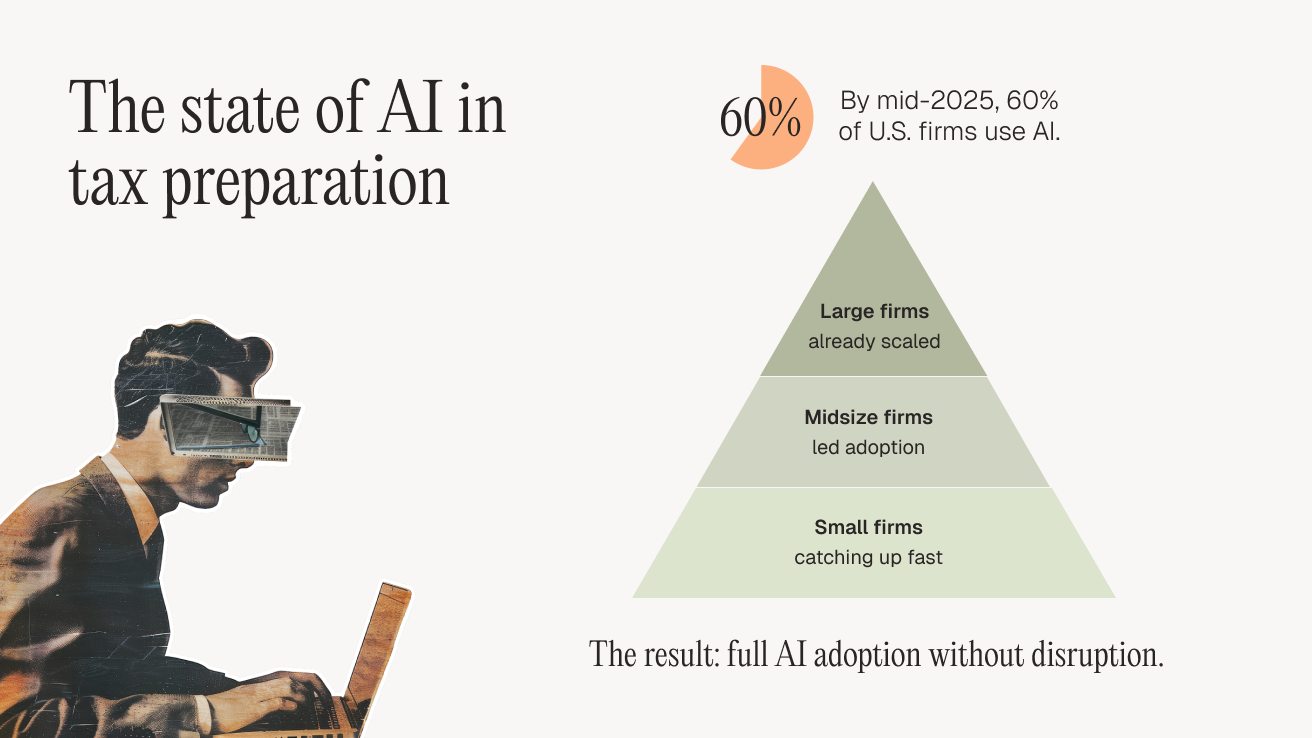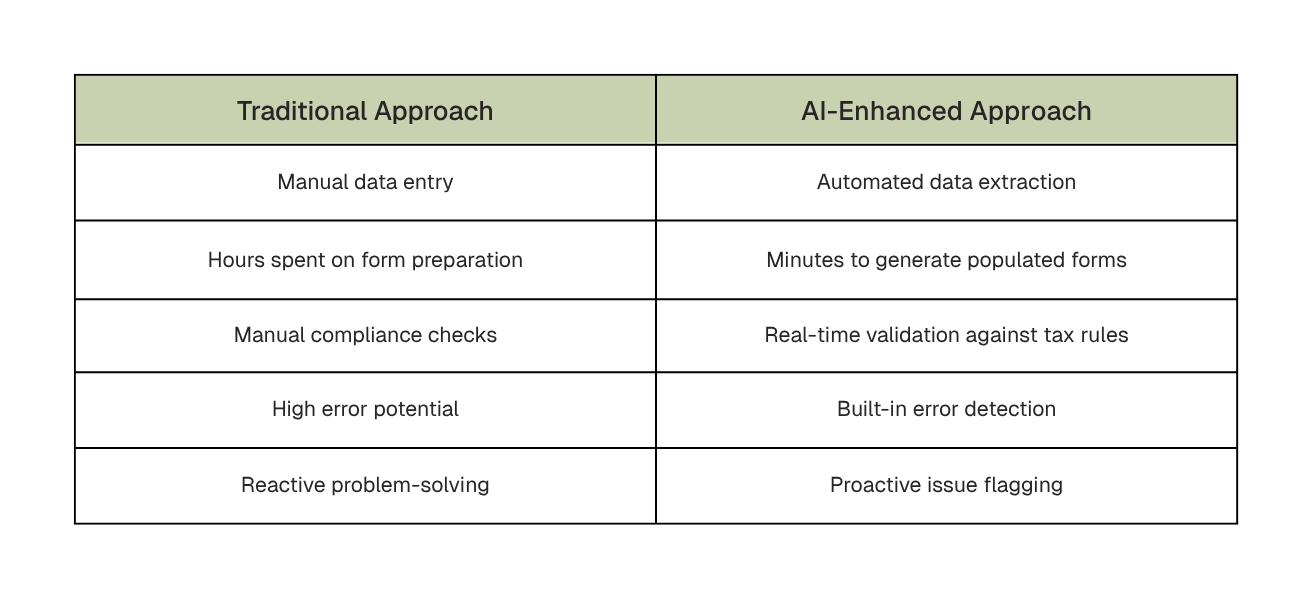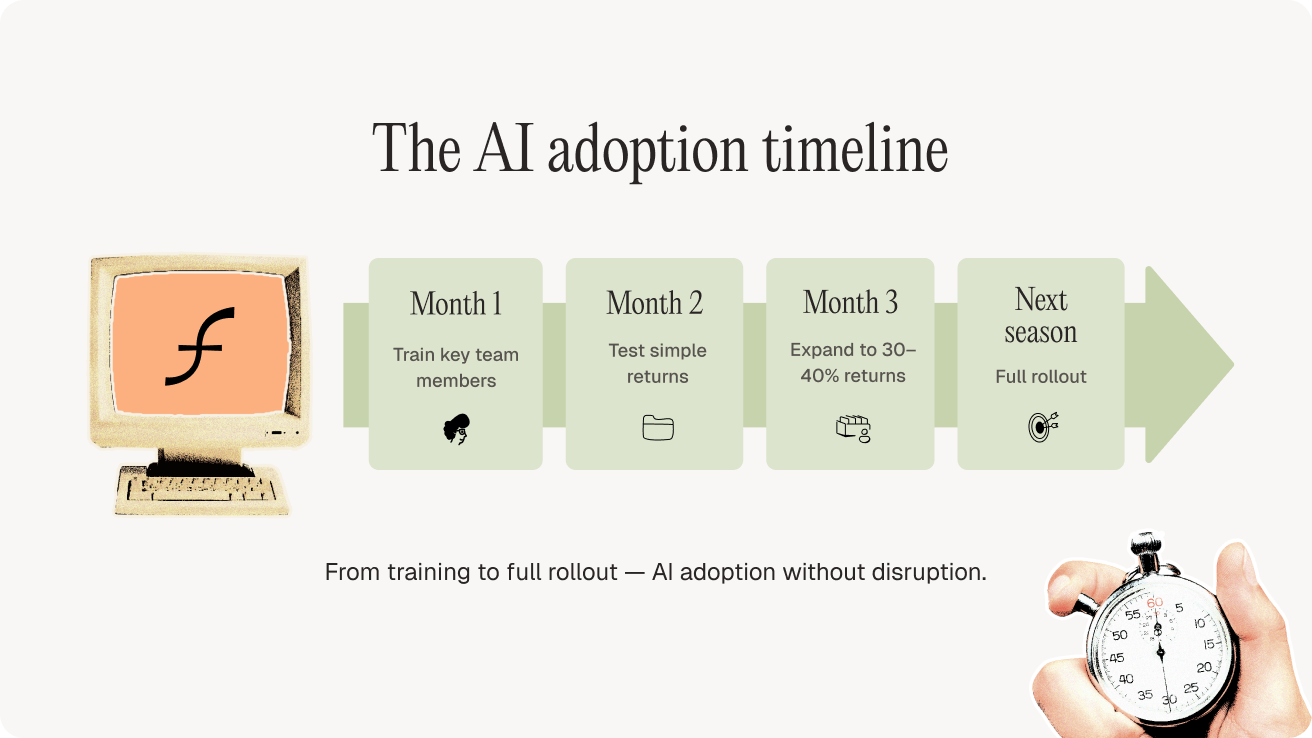Every tax pro already knows the drill. Tax season means paperwork mountains, long hours, and too few staff to dig out. The profession has been running on fumes for years, and the cracks are showing.
That’s why AI isn’t optional anymore. In 2025, it’s the difference between firms that scale and firms that stall. Not hype. Not “the future.” Just the practical fix for a broken system.
Where AI stands in tax preparation today
As of mid-2025, about 60% of U.S. firms are using AI somewhere in their tax workflows. Midsize and large firms moved first. Smaller practices are catching up because the math is too obvious to ignore.
Right now, AI in tax prep handles:
- Pulling data directly from client docs.
- Populating forms without anyone typing it in.
- Catching errors and inconsistencies in real time.
- Flagging edge cases for review.
The result? Firms are completing returns up to 3x faster. And unlike seasonal staff, AI doesn’t quit after April.
And with the right AI tool, improved efficiency doesn't come at the expense of accuracy or compliance. AI enhances both efficiency and accuracy while reducing risk.

Why efficiency, accuracy, and risk reduction matter
These aren’t buzzwords. They’re survival metrics.
- Efficiency: AI cuts routine prep tasks by 75–90%. Firms using it prep returns 60–75% faster without adding staff.
- Accuracy: Manual entry is where most mistakes creep in. AI pulls and cross-checks with precision, dropping error rates by ~40%.
- Risk reduction: AI systems don’t wait for staff to remember the new rule. They’re updated instantly. They flag audit triggers in real time and log every step for defense.
Compare the traditional approach with the AI-enhanced approach:

One’s a bottleneck. The other’s a force multiplier.
Overcoming barriers to AI adoption
“It’s too expensive.”
Not anymore. Subscription pricing makes AI accessible, and ROI is usually obvious within one season. Save 2 hours per return at $150/hour billing — do the math.
“What about security?”
Modern AI platforms meet or exceed bank-level security: AES-256 encryption, SOC 2 Type II compliance, audit trails, and secure cloud backups. Safer than the paper stacks still sitting on some desks.
“Will it pay off?”
Data says yes. Firms are experiencing:
- $100+ average savings per return
- 50% shorter review cycles
- 30–40% more returns processed with the same staff
- Less overtime and higher retention
If your AI doesn’t return value by April 15, it’s the wrong platform.
AI-powered workflows and real-time compliance
Let's walk through how AI actually transforms the tax preparation process, enabling ax pros to spend less time on data entry and more time on analysis and client service.
Before AI: manual sorting, hours of typing, delayed error discovery, tax code buried in binders.
After AI: instant document classification, data auto-filled, inconsistencies flagged immediately, built-in compliance updates.
The workflow flips:
- AI handles: Document intake, data organization, validation, compliance monitoring.
- Humans handle: Edge cases, interpretation, client conversations, final sign-off.
It’s not man vs. machine. It’s man plus machine vs. inefficiency.
Bridging the gap between automation and expertise
AI isn’t replacing professionals. It’s removing the deadweight tasks so pros can actually use their expertise.
AI's role:
- Extract data from documents
- Populate tax forms
- Flag potential issues
- Apply standard tax rules
- Maintain audit trails
Tax pro’s role:
- Review AI-prepared returns
- Handle complex tax situations
- Apply professional judgment
- Manage client relationships
- Provide strategic tax advice
This split gives firms leverage: more time for strategy, stronger client relationships, and staff who aren’t crushed by data entry. Clients don’t lose the human touch. They finally get more of it.
Implementing AI without disrupting existing Systems
Adding AI doesn’t mean starting from scratch.
Check your current stack. Does it integrate with your tax software, like Access CCH, UltraTax, ProConnect, Drake? Filed does. Ask:
- Does it connect directly to my tax software?
- Can it read the document formats my clients typically provide?
- Will it work with my current client portal?
Roll out in phases. Start with simple returns. Expand as confidence grows.
- Begin with simple 1040s with W-2 income
- Add Schedule C returns next
- Move to more complex returns as confidence grows
Train your team. Admins learn upload. Preparers learn review. Managers track quality. Most users are comfortable inside a week.

Timeline? Two to six weeks. Quicker than hiring and training a seasonal staffer.
The path forward for tax professionals
The tax professional of 2025 doesn’t spend nights buried in paperwork. They spend their time advising clients, spotting planning opportunities, and building a firm that scales without breaking.
Filed makes that possible by automating the drudgery while keeping you in control. We don’t sell hype. We sell speed.
Apply for early access at https://www.filed.com/early-access.
FAQs about AI in tax preparation
How does AI handle complex cases?
It flags edge cases for human review while processing the standard pieces automatically.
Is it secure?
Yes. SOC 2, AES-256, audit trails, role-based access. Stronger than most firms’ current setups.
How fast can we implement?
2–6 weeks. Faster than onboarding seasonal staff.
Does it integrate with existing software?
Yes — Filed connects directly with major tax prep platforms.
That’s the state of AI in 2025: not futuristic, not experimental, just the practical way to survive and scale tax season.




.png)

